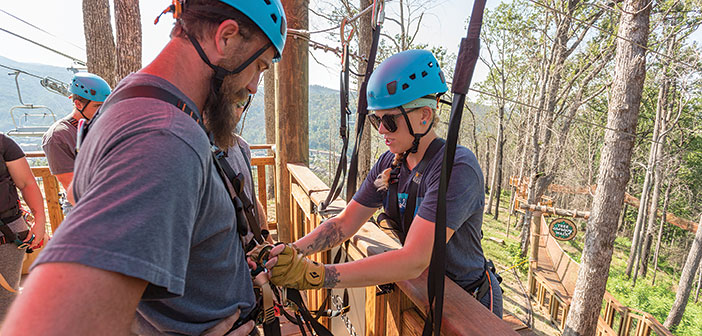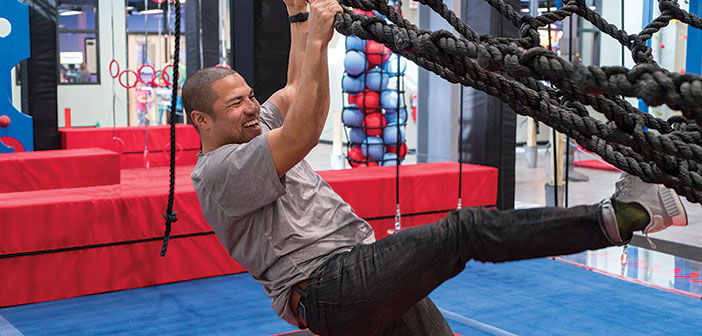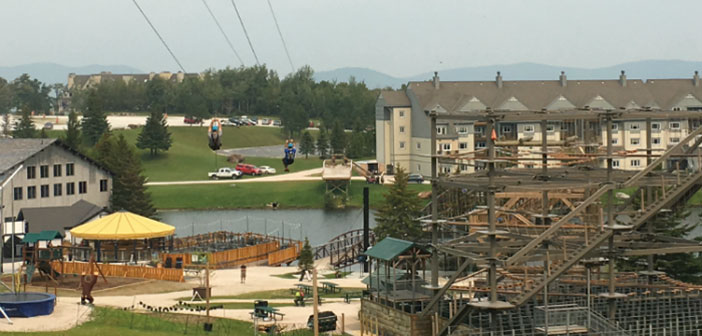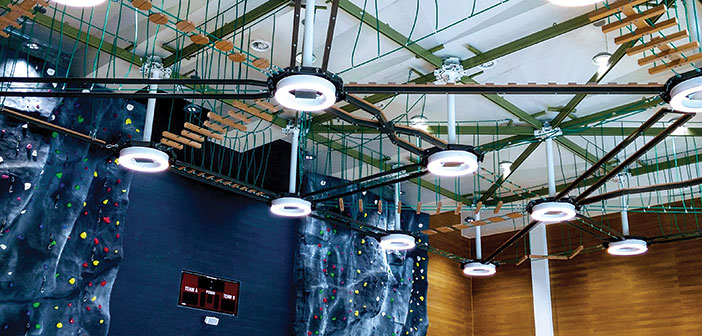People often ask, “Where is our industry going?” It’s an interesting question, given that we are still in the infancy stages of an industry that is growing at an exponential rate. While it’s impossible to predict the future with 100 percent accuracy, there are some clear signals from which we can learn.
As our industry has grown, technology and larger budgets have allowed adventure attractions to evolve quickly. And, as aerial adventure gets more and more popular, bigger players are paying attention and entering the field. Ski areas, amusement parks, and family entertainment centers are all getting into the adventure game.
And just what does the game look like today? Here are eight trends that we are seeing as we work around the country and the globe, pontificating about the joys of adventure businesses.
Travel Distances Are Shrinking
It wasn’t that long ago that people would travel several hours for aerial attractions like a zip line tour. When we wrote business plans, we would examine market demographics and competitive data for a radius that extended for many hours in every direction, and sometimes across an entire state or region.
Now, zip line tours are becoming much more commonplace, and their depth and variety has increased as well. On average, the time people are willing to travel has shrunk to about an hour, and it’s even less for other attractions, such as aerial adventure parks. That’s not to say that visitors won’t still travel hours for a tour in the rainforest of Maui or the treetops of Alaska, but most new attractions won’t be able to cast as wide a net as they once could.
Multiple Locations from One Brand
As communities start to acquire more local aerial attractions, certain brands have developed multiple attractions across different regions. Companies like GoApe and Outdoor Ventures each have seven or more locations across the country, and we hear from providers almost every week that are looking to develop a similar business model.
The prospect is attractive—it’s easier to replicate an existing, successful model than it is to create an entirely new one, and the potential for revenue is much higher. If you are reading this right now and thinking to yourself, “Hmm…I should get on that,” keep in mind the following:
- A consistent brand is a strong brand, so the more consistent the guest experience that you can provide across locations, the better.
- That said, each market is a bit different—just because one location supported a certain type of activity or pricing structure, that doesn’t mean they all will.
- If you are new to the industry, it’s better to start with one location than to go all-in on multiple locations. There’s plenty to be learned from experience, and it’s better to learn once than multiple times.
Multi-Attraction Sites
The days of standalone aerial parks may be numbered. Many companies have expanded their services, not by adding more locations, but by adding more attractions to a single location. Multi-attraction facilities are becoming the norm as jump towers, climbing walls, and jump pads, to name three popular options, are being integrated into parks’ offerings from day one. Anakeesta Mountain in Tennessee, Epic Adventures in Colorado, and Quarry Park Adventures in California are just some of the multi-attraction parks that have cropped up recently.

The racing zip line is just one of the many activities and attractions at Anakeesta, Tenn., which followed the multi-attraction model from day one.
Even if you don’t have the space to build a zip coaster or the luxury of an on-site chairlift, it’s probably a good idea to consider expanding upon or adding value to your existing attraction. Many adventure parks have expanded by adding kids’ courses, single-ride zip lines, or canopy walks. You can also add some pizzazz by swapping out your elements seasonally.
The more the industry continues to expand, the more likely your guests are to want something different each time they come back. Or, as we like to say (for those in the know)…SQUIRREL!
Indoor Facilities
While the terms “adventure” and “indoors” don’t always seem to go hand-in-hand, more and more adventure facilities are being built in large indoor spaces. Ropes Courses Inc., started the trend with its steel-constructed ropes courses, and indoor construction has evolved to include wooden pole courses, ninja-style activities, and even parkour-based elements.

“Ninja Warrior”-style courses are becoming popular at indoor facilities, including those with a family focus, like the new Fun Zone 2.0 at Smugglers’ Notch, Vt.
Some of the advantages of operating indoors are obvious: weather is no longer a factor, sites can operate year-round, and it sure is nice to climb in a climate-controlled environment in the middle of an already populated area.
Other advantages may not be as apparent, but certainly start to add up. For one, it’s nice to show up for work and not need to worry if a tree fell on the course and damaged elements, and small things like paved parking and generally easier-to-navigate locations can make this type of facility feel more accessible.
The downsides? It’s MUCH more expensive to set up an indoor facility from scratch, and most ready-built buildings don’t have much more than 25 feet of ceiling height. And the advantages of indoor facilities can also be disadvantages. While there’s something to be said for climbing in an air-conditioned space with music blasting, an indoor facility just can’t provide the same sense of adventure that a tree-based park can.
Ski Areas Adding More Summer Attractions
Speaking of outdoor, tree-based facilities, a few years ago we began to see ski areas in the U.S. and Canada developing summer attractions. While this has been the trend throughout Europe for several decades now, it’s only just recently begun to catch on here. Early attractions, which are still trending now, included zip line tours and alpine slides. More recently we are seeing the inclusion of aerial adventure parks, mazes, and a whole host of other attractions at ski resorts.

Killington Resort in Vermont is one of several ski resorts in North America investing heavily in high-throughput aerial adventure and gravity-fed attractions.
Ski areas generally tend to gravitate toward attractions that have a higher throughput, in order to best emulate the ski and snowboard experience. As we all know, it can take a minute (or 30) to harness-up participants and teach them the ins and outs of aerial attractions. As a result, many ski resorts have taken advantage of their natural terrain to maximize throughput by adding gravity-fed attractions like mountain coasters, updated alpine slides, zip coasters, and, of course, downhill mountain biking.
Like any other trend, there were a few pioneers in the realm of summer attractions. Winter Park Resort in Colorado has had mountain biking and alpine slides for many years. However, summer attractions are not limited to major ski resorts out West. Some of the most elaborate year-round attractions are located on smaller properties in New England, the Midwest, and eastern Canada.
Amusement Parks Jumping In
Much like ski resorts, amusement parks want to get in on the aerial attraction industry as well. Many amusement parks across the United States are considering or adding adventure attractions to their current offerings. Amusement parks also tend to gravitate toward the higher-throughput activities in order to stay on brand with their other attractions, so you are more likely to see a zip coaster than a double-black-diamond aerial trail at your local Six Flags.
Commercial Lending Growth
Given the scale and scope with which the industry has caught on, we are now seeing commercial lenders loosening their purse strings a bit for aerial attractions. While many businesses in the startup phase without any prior experience are still heavily reliant on private investment, those with industry experience are finding it easier to obtain bank financing. Often these are SBA (Small Business Administration)-type loans. It is still a difficult road to get traditional financing (plan on at LEAST six months to get it all figured out), but it is no longer the impossible task of yesteryear. If you have three or more years of operating history, getting an expansion loan gets even easier.
International Expansion
It was not long ago that zip line tours were associated with vacations in Costa Rica and Hawaii, while adventure parks were those things that you climbed on in Switzerland. As the industry has expanded domestically, international providers have started to catch on as well.
From wilderness locations to indoor malls, from China to the Caribbean, every region with a population big enough to support it is looking to build an aerial park, zip line tour, or other aerial attraction.
By the time you finish reading this, something new will have happened in the industry—that’s how fast it’s moving. All of the changes that are afoot can leave you wondering if you should open your chain of adventure parks across the Southwest or build the longest zip line in the world in Dubai (although it’s too late for the latter—at press time, that was already slated for December 2017). While it may seem overwhelming, here are some factors to keep in mind as you work your way through this industry:
WHAT DOES THIS MEAN TO ME?
STAY ON TOP OF WHAT’S OUT THERE: We understand how easy it is to get caught up in the day-to-day operations of your business and lose sight of everything else going on in the industry. We’re not saying that you need to spend hours a day on Google researching the latest and greatest, but it doesn’t hurt to visit the occasional aerial attraction while you are on vacation, attend the ACCT Conference and/or IAAPA, or subscribe to publications like this one. And remember to check out adventureparkinsider.com from time to time.
FOCUS ON WHAT YOU ARE GOOD AT: There’s no reason to expand into an area that you’re unfamiliar with, simply because it’s the current trend. Remember, your existing customers are often your best source of marketing, so when in doubt, consider what they would want to see (and it doesn’t hurt to ask!).
MAKE SURE IT’S FEASIBLE: Just because the mountain coaster in Colorado was awesome (and they are awesome), it doesn’t necessarily mean you should open one in Nebraska. No matter what the expansion option is, we suggest going through some sort of process to determine the feasibility. There are hundreds of factors that will inform whether or not a new attraction is feasible, and it’s much better to invest in a little research than to go all-in and gamble with your money.
KEEP IT INTERESTING: We periodically like to ask our clients if they have 20 years of experience, or one year of experience that they have repeated for the past 20 years. As the industry evolves, customers are constantly looking for the next thing, and any adjustment to your park that you can make—no matter how big or how small—just might be the difference for your new and returning guests.
From equipment to elements, from concessions to the attractions themselves, the more you can refresh what you are offering, the more likely you are to keep your customers coming back again and again.



